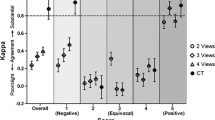Abstract
Purpose
The diagnosis and classification of ossification of the posterior longitudinal ligament (OPLL) can be difficult with radiography alone; therefore, computed tomography (CT) is also usually performed. There are many reports on the usefulness of digital tomosynthesis (DTS) for image analysis in orthopedics. This study aimed to compare the accuracy of DTS with radiography and CT for the diagnosis and classification of cervical OPLL (C-OPLL).
Materials and methods
We included 31 patients with OPLL and 30 with cervical spondylotic myelopathy. The patients' cervical spine radiography, DTS, and CT images were each evaluated twice by three specialists and three residents.
Results
In the intra-observer reliability study, there was one observer with a fair level of kappa values for radiography and DTS among three residents. The kappa values for CT were the best for all observers. In the inter-observer reliability study, the interclass correlation coefficient (ICC) values were high for both diagnosis and classification by specialists at the almost perfect level for all three imaging modalities. On the other hand, the ICC values for both diagnosis and classification for radiography by the residents were lower than those for DTS and CT.
Conclusions
This study revealed that DTS may be an alternative to CT for the diagnosis and classification of C-OPLL by specialists. Caution should be exercised in diagnosing and classifying C-OPLL using radiography and DTS by residents, and the use of CT is recommended.

Similar content being viewed by others
References
Tsukimoto H (1960) A case report-autopsy of syndrome of compression of spinal cord owing to ossification within spinal canal of cervical spines. Arch Jpn Chir 29:1003–1007
Fujimori T, Le H, Hu SS et al (2015) Ossification of the posterior longitudinal ligament of the cervical spine in 3161 patients: a CT-based study. Spine (Phila Pa 1976) 40(7):394. https://doi.org/10.1097/BRS.0000000000000791
Yoshimura N, Nagata K, Muraki S et al (2014) Prevalence and progression of radiographic ossification of the posterior longitudinal ligament and associated factors in the Japanese population: a 3-year follow-up of the ROAD study. Osteoporos Int 25(3):1089–1098. https://doi.org/10.1007/s00198-013-2489-0
Sasaki E, Ono A, Yokoyama T et al (2014) Prevalence and symptom of ossification of posterior longitudinal ligaments in the Japanese general population. J Orthop Sci 19(3):405–411. https://doi.org/10.1007/s00776-014-0552-0
Chikuda H, Seichi A, Takeshita K et al (2011) Acute cervical spinal cord injury complicated by preexisting ossification of the posterior longitudinal ligament: a multicenter study. Spine (Phila Pa 1976) 36(18):1453–1458. https://doi.org/10.1097/BRS.0b013e3181f49718
Tsuyama N (1984) Ossification of the posterior longitudinal ligament of the spine. Clin Orthop Relat Res 184(184):71–84
Xia W, Yin XR, Wu JT, Wu HT (2013) Comparative study of DTS and CT in the skeletal trauma imaging diagnosis evaluation and radiation dose. Eur J Radiol 82(2):e76-80. https://doi.org/10.1016/j.ejrad.2012.09.008
Biswas D, Bible JE, Bohan M et al (2009) Radiation exposure from musculoskeletal computerized tomographic scans. J Bone Joint Surg Am 91(8):1882–1889. https://doi.org/10.2106/JBJS.H.01199
Göthlin JH, Geijer M (2013) The utility of digital linear tomosynthesis imaging of total hip joint arthroplasty with suspicion of loosening: a prospective study in 40 patients. BioMed Res Int 2013:594631. https://doi.org/10.1155/2013/594631
Machida H, Yuhara T, Mori T et al (2010) Optimizing parameters for flat-panel detector digital tomosynthesis. Radiographics 30(2):549–562. https://doi.org/10.1148/rg.302095097
Oishi K, Inoue R, Yamamoto Y et al (2021) Assessment of early biological fixation of cementless tapered-wedge stems using digital tomosynthesis. J Arthroplast 36(9):3209–3213. https://doi.org/10.1016/j.arth.2021.04.021
Hayashi D, Xu L, Roemer FW et al (2012) Detection of osteophytes and subchondral cysts in the knee with use of tomosynthesis. Radiology 263(1):206–215. https://doi.org/10.1148/radiol.12111649
Ishibashi K, Sasaki E, Wijaya E et al (2022) A novel quantitative evaluation of bone formation after opening wedge high tibial osteotomy using tomosynthesis. J Digit Imaging. https://doi.org/10.1007/s10278-022-00630-x
Landis JR, Koch GG (1977) The measurement of observer agreement for categorical data. Biometrics 33(1):159–174. https://doi.org/10.2307/2529310
Joo YB, Kim TH, Park J et al (2017) Digital tomosynthesis as a new diagnostic tool for evaluation of spine damage in patients with ankylosing spondylitis. Rheumatol Int 37(2):207–212. https://doi.org/10.1007/s00296-016-3627-8
Kudo H, Yokoyama T, Tsushima E et al (2013) Interobserver and intraobserver reliability of the classification and diagnosis for ossification of the posterior longitudinal ligament of the cervical spine. Eur Spine J 22(1):205–210. https://doi.org/10.1007/s00586-012-2573-8
Fujiyoshi T, Yamazaki M, Kawabe J et al (2008) A New concept for making decisions regarding the surgical approach for cervical ossification of the posterior longitudinal ligament: the K-line. Spine (Phila Pa 1976) 33(26):E990. https://doi.org/10.1097/BRS.0b013e318188b300
Takeuchi K, Yokoyama T, Numasawa T et al (1891) (2016) K-line (-) in the neck-flexed position in patients with ossification of the posterior longitudinal ligament is a risk factor for poor clinical outcome after cervical laminoplasty. Spine (Phila Pa 1976) 41(24):24. https://doi.org/10.1097/BRS.0000000000001660
Tsujimoto T, Endo T, Menjo Y et al (2021) Exceptional conditions for favorable neurological recovery after laminoplasty in cases with cervical myelopathy caused by K-line (-) ossification of posterior longitudinal ligament. Spine (Phila Pa 1976) 46(15):990. https://doi.org/10.1097/BRS.0000000000003945
Acknowledgements
We would like to thank Editage (www.editage.com) for English language editing.
Funding
The authors did not receive support from any organization for the submitted work.
Author information
Authors and Affiliations
Corresponding author
Ethics declarations
Conflict of interests
The authors have no relevant financial or non-financial interests to disclose.
Ethical approval
This study was approved by the ethics committee of the Hirosaki University Graduate School of Medicine (IRB number: 2019–1038).
Additional information
Publisher's Note
Springer Nature remains neutral with regard to jurisdictional claims in published maps and institutional affiliations.
Rights and permissions
Springer Nature or its licensor (e.g. a society or other partner) holds exclusive rights to this article under a publishing agreement with the author(s) or other rightsholder(s); author self-archiving of the accepted manuscript version of this article is solely governed by the terms of such publishing agreement and applicable law.
About this article
Cite this article
Asari, T., Wada, K., Kumagai, G. et al. Usefulness of digital tomosynthesis in diagnosing cervical ossification of the posterior longitudinal ligament: a comparative study with other imaging modalities. Eur Spine J 31, 3470–3476 (2022). https://doi.org/10.1007/s00586-022-07430-5
Received:
Revised:
Accepted:
Published:
Issue Date:
DOI: https://doi.org/10.1007/s00586-022-07430-5




